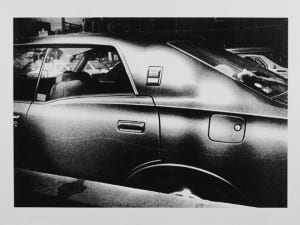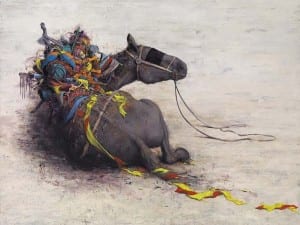Darren Almond’s To Leave a Light Impression at White Cube, Bermondsey, includes his photography series Fullmoon and Present Form, enthralling the audience across three large rooms divided by three white walls. Standing at the threshold of the first room, Almond’s large-scale C-type print of Cape Verde, Fullmoon at Cape Verde (2013), moves the viewer from the gallery space to an undefinable realm of winds’ unrelenting quietude. The series of photographs exhibited in this section were taken under the light of a full moon using long exposure in every continent over a period of 13 years.
Across from the bluer than blue photograph taken in Cape Verde, a quotation from Scottish writer Nan Shepherd’s The Living Mountain (1977:93) is inscribed on 11 cast bronze and cream painted train plates. Almond’s work suitably titled, Laurentia (2012) juxtaposes Shepherd’s writing into our day: “So there I lie on the plateau, under me the central core of the fire, from which was thrust this grumbling, grinding mass of plutonic rock, over me the blue air, and between the fire of the rock and the fire of the sun, scree, soil and water, moss, grass, flower and tree, insect, bird and beast, rain and snow – the total mountain. Slowly I have found my way in.” Nowadays few feel the earth the way Nan Shepherd, an avid hiker, felt it. However, it seems Almond has also done his share of sucking the energy of the sceneries he cast his gaze on, to transpose places that most of us may not even have the chance to see in person into works of photography.
Everything in Almond’s photographs breathe; the rocks, the mist, the ocean, the colours and the light. Infinity lies at the heart of his works. The sceneries are not limited by the boundaries of the frames; on the contrary they open the mind’s eye to imagination. As one views the photographs, one is standing there; on solidified lava, on grass or on moss, and looking through the lens of Almond’s camera, or accompanying Charles Darwin on his second HMS Beagle expedition, during which he gathered important findings that he would later include in his much-debated and renowned work On the Origin of Species (1859).
Almond’s other series, Present Form (2013) rises on the walls of the second room and comprises of photographs of standing stones on the Isle of Lewis in the Outer Hebrides. The standing stones, dating from 3000 BC, are a part of a stone circle near Callanish Village and are known as the Callanish Stones. These archeo-astronomical stones resonate the passing of time as moss and various other vegetation adorns them in places, making them seem almost human. Another cast bronze train plate mounted on the wall to the left reads, Between Here and the Surface of the Moon (2013) accompanies 6 sets of hand-polished bronze cylindrical sculptures filled with lead and inscribed with the initials of astronauts who have walked on the moon, rest on the floor. Almond’s metaphor that human’s die and become a part of the soil, the air and the atmosphere while the stones stand amidst it all and only age slowly, is reflected by the positioning of the cylindrical bronze sculptures. The bronze sculptures standing tall and proud like the standing stones of Callanish are a dedication to those astronauts who are still alive while those lying vertically on the ground are an homage to those whom we have lost to the cruelty of time only felt by the mortal.
In the third section of the exhibition, Almond’s tripartite photograph of the surface of the Perito Moreno Glacier in Argentine Patagonia leaves a very strong impression on the conscience of the viewer. Accommodated in a silver-coloured frame, the triptych has an overwhelming presence. Layers of ice recall the celadon ceramics of ancient Korea, half-translucent and half dark. The Perito Moreno Glacier, one of the only three Patagonian glaciers that are still recorded to be growing, seems to defy the damage inflicted on the planet by the ever-increasing human population. Though chiselled by fast winds and climate change, the Glacier juts out of the icy waters that surround it and continues to protect itself from human occupation with every heaving crack formed in its overwhelming body.
In To Leave a Light Impression Darren Almond stands before nature, between man and nature, between man and space, between life and death, and looks at the sad beauty of everything that is reflected through the lens of his camera. Almond slowly finds his way into the core of the earth and into the total mountain to directly stare into all that has been of this world throughout millennia.
To Leave a Light Impression until 13 April at the South Galleries of the White Cube, 144 – 152 Bermondsey Street, London SE1 3TQ. In March 2014, a 360-page hardback book titled, Fullmoon by Darren Almond will be published by Taschen.
Hande Eagle
Credits
1. Fullmoon@Cape Verde.
2. Fullmoon@Cerro Chaltén





